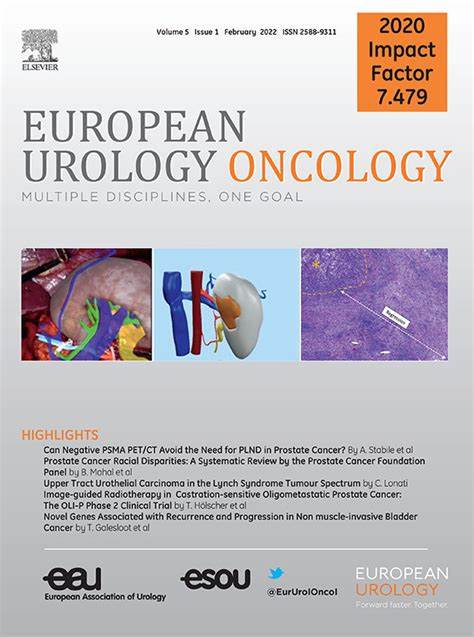膀胱癌根治性切除术后随访的一致性:基于欧洲泌尿外科协会膀胱癌指南小组合作开发的专家实践框架。
IF 8.3
1区 医学
Q1 ONCOLOGY
引用次数: 0
摘要
背景和目的:膀胱癌(BC)根治性膀胱切除术(RC)后的随访没有标准化方案。为了填补这一空白,我们开展了一项多中心研究,欧洲泌尿外科协会(EAU)膀胱癌指南小组的泌尿科医生参与了这项研究。我们的目标是确定一致的 RC 后随访策略,并根据专家意见制定一个基于实践的框架:我们使用一份预先测试过的二分法问卷,对欧洲泌尿学协会非肌层浸润性膀胱癌、肌层浸润性膀胱癌和转移性膀胱癌指南小组的 27 位泌尿学专家进行了调查。调查询问了 RC 后的随访策略以及风险适应策略的使用情况。RC后3个月开始的随访实践中,>75%的肯定回答为一致性。我们使用了描述性统计进行分析:我们收到了96%的专家组成员的回复,他们提供了来自21家欧洲医院的数据。53%的医院采用风险适应性随访,对高风险(至少≥pT3或pN+)和低风险([y]pT0/a/1N0)病例采用统一标准。在未就基于风险的随访达成一致意见的情况下,制定了非风险适应性随访框架。在最初的 3 年中,随访的一致性较高,但在随后的随访中一致性有所下降。第一年的随访最为频繁,包括患者评估、体格检查和实验室检测。胸部和腹部/骨盆的计算机断层扫描是最常见的成像方式,最初至少每半年进行一次,然后在第二年至第五年每年进行一次。RC术后10年后的持续随访缺乏一致性:在缺乏前瞻性随机研究的情况下,EAU膀胱癌专家制定的这一基于实践的RC后随访框架可为泌尿科医生提供有价值的指导。患者摘要:我们向EAU膀胱癌指南小组的泌尿科医生询问了膀胱癌手术切除后的患者随访情况。我们发现,虽然泌尿科医生的方法各不相同,但整个小组也有一些共同的随访做法。我们创建了一个实用的随访框架,对泌尿科医生的日常工作很有帮助。本文章由计算机程序翻译,如有差异,请以英文原文为准。
Consistencies in Follow-up After Radical Cystectomy for Bladder Cancer: A Framework Based on Expert Practices Collaboratively Developed by the European Association of Urology Bladder Cancer Guideline Panels
Background and objective
There is no standardized regimen for follow-up after radical cystectomy (RC) for bladder cancer (BC). To address this gap, we conducted a multicenter study involving urologist members from the European Association of Urology (EAU) bladder cancer guideline panels. Our objective was to identify consistent post-RC follow-up strategies and develop a practice-based framework based on expert opinion.
Methods
We surveyed 27 urologist members of the EAU guideline panels for non–muscle-invasive bladder cancer and muscle-invasive and metastatic bladder cancer using a pre-tested questionnaire with dichotomous responses. The survey inquired about follow-up strategies after RC and the use of risk-adapted strategies. Consistency was defined as >75% affirmative responses for follow-up practices commencing 3 mo after RC. Descriptive statistics were used for analysis.
Key findings and limitations
We received responses from 96% of the panel members, who provided data from 21 European hospitals. Risk-adapted follow-up is used in 53% of hospitals, with uniform criteria for high-risk (at least ≥pT3 or pN+) and low-risk ([y]pT0/a/1N0) cases. In the absence of agreement for risk-based follow up, a non-risk-adapted framework for follow-up was developed. Higher conformity was observed within the initial 3 yr, followed by a decline in subsequent follow-up. Follow-up was most frequent during the first year, including patient assessments, physical examinations, and laboratory tests. Computed tomography of the chest and abdomen/pelvis was the most common imaging modality, initially at least biannually, and then annually from years 2 to 5. There was a lack of consistency for continuing follow-up beyond 10 yr after RC.
Conclusions and clinical implications
This practice-based post-RC follow-up framework developed by EAU bladder cancer experts may serve as a valuable guide for urologists in the absence of prospective randomized studies.
Patient summary
We asked urologists from the EAU bladder cancer guideline panels about their patient follow-up after surgical removal of the bladder for bladder cancer. We found that although urologists have varying approaches, there are also common follow-up practices across the panel. We created a practical follow-up framework that could be useful for urologists in their day-to-day practice.
求助全文
通过发布文献求助,成功后即可免费获取论文全文。
去求助
来源期刊

European urology oncology
Multiple-
CiteScore
15.50
自引率
2.40%
发文量
128
审稿时长
20 days
期刊介绍:
Journal Name: European Urology Oncology
Affiliation: Official Journal of the European Association of Urology
Focus:
First official publication of the EAU fully devoted to the study of genitourinary malignancies
Aims to deliver high-quality research
Content:
Includes original articles, opinion piece editorials, and invited reviews
Covers clinical, basic, and translational research
Publication Frequency: Six times a year in electronic format
 求助内容:
求助内容: 应助结果提醒方式:
应助结果提醒方式:


